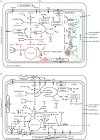Endosymbiotic associations within protists
- PMID: 20124339
- PMCID: PMC2817226
- DOI: 10.1098/rstb.2009.0188
Endosymbiotic associations within protists
Abstract
The establishment of an endosymbiotic relationship typically seems to be driven through complementation of the host's limited metabolic capabilities by the biochemical versatility of the endosymbiont. The most significant examples of endosymbiosis are represented by the endosymbiotic acquisition of plastids and mitochondria, introducing photosynthesis and respiration to eukaryotes. However, there are numerous other endosymbioses that evolved more recently and repeatedly across the tree of life. Recent advances in genome sequencing technology have led to a better understanding of the physiological basis of many endosymbiotic associations. This review focuses on endosymbionts in protists (unicellular eukaryotes). Selected examples illustrate the incorporation of various new biochemical functions, such as photosynthesis, nitrogen fixation and recycling, and methanogenesis, into protist hosts by prokaryotic endosymbionts. Furthermore, photosynthetic eukaryotic endosymbionts display a great diversity of modes of integration into different protist hosts. In conclusion, endosymbiosis seems to represent a general evolutionary strategy of protists to acquire novel biochemical functions and is thus an important source of genetic innovation.
Figures



Similar articles
-
The endosymbiotic origin, diversification and fate of plastids.Philos Trans R Soc Lond B Biol Sci. 2010 Mar 12;365(1541):729-48. doi: 10.1098/rstb.2009.0103. Philos Trans R Soc Lond B Biol Sci. 2010. PMID: 20124341 Free PMC article. Review.
-
How did cyanobacteria first embark on the path to becoming plastids?: lessons from protist symbioses.FEMS Microbiol Lett. 2018 Oct 1;365(19). doi: 10.1093/femsle/fny209. FEMS Microbiol Lett. 2018. PMID: 30165400 Review.
-
Genomics-Informed Insights into Endosymbiotic Organelle Evolution in Photosynthetic Eukaryotes.Annu Rev Plant Biol. 2018 Apr 29;69:51-84. doi: 10.1146/annurev-arplant-042817-040209. Epub 2018 Feb 28. Annu Rev Plant Biol. 2018. PMID: 29489396 Review.
-
Endosymbiosis: double-take on plastid origins.Curr Biol. 2006 Sep 5;16(17):R690-2. doi: 10.1016/j.cub.2006.08.006. Curr Biol. 2006. PMID: 16950094
-
Origin and evolution of plastids and photosynthesis in eukaryotes.Cold Spring Harb Perspect Biol. 2014 Apr 1;6(4):a016105. doi: 10.1101/cshperspect.a016105. Cold Spring Harb Perspect Biol. 2014. PMID: 24691960 Free PMC article. Review.
Cited by
-
"Candidatus Intestinibacterium parameciiphilum"-member of the "Candidatus Paracaedibacteraceae" family (Alphaproteobacteria, Holosporales) inhabiting the ciliated protist Paramecium.Int Microbiol. 2024 Jun;27(3):659-671. doi: 10.1007/s10123-023-00414-5. Epub 2023 Aug 24. Int Microbiol. 2024. PMID: 37615902 Free PMC article.
-
Eukaryotic origins: How and when was the mitochondrion acquired?Cold Spring Harb Perspect Biol. 2014 Jul 18;6(12):a015990. doi: 10.1101/cshperspect.a015990. Cold Spring Harb Perspect Biol. 2014. PMID: 25038049 Free PMC article. Review.
-
Life Cycle, Ultrastructure, and Phylogeny of New Diplonemids and Their Endosymbiotic Bacteria.mBio. 2018 Mar 6;9(2):e02447-17. doi: 10.1128/mBio.02447-17. mBio. 2018. PMID: 29511084 Free PMC article.
-
Toxic or Otherwise Harmful Algae and the Built Environment.Toxins (Basel). 2021 Jun 30;13(7):465. doi: 10.3390/toxins13070465. Toxins (Basel). 2021. PMID: 34209446 Free PMC article. Review.
-
Intracellular symbiosis of algae with possible involvement of mitochondrial dynamics.Sci Rep. 2017 Apr 27;7(1):1221. doi: 10.1038/s41598-017-01331-0. Sci Rep. 2017. PMID: 28450706 Free PMC article.
References
-
- Akman L., Yamashita A., Watanabe H., Oshima K., Shiba T., Hattori M., Aksoy S.2002Genome sequence of the endocellular obligate symbiont of tsetse flies, Wigglesworthia glossinidia. Nat. Genet. 32, 402–407 (doi:10.1038/ng986) - DOI - PubMed
-
- Andersson J. O.2005Lateral gene transfer in eukaryotes. Cell. Mol. Life Sci. 62, 1182–1197 (doi:10.1007/s00018-005-4539-z) - DOI - PMC - PubMed
-
- Archibald J. M.2009The puzzle of plastid evolution. Curr. Biol. 19, R81–R88 (doi:10.1016/j.cub.2008.11.067) - DOI - PubMed
-
- Baumann P.2005Biology of bacteriocyte-associated endosymbionts of plant sap-sucking insects. Annu. Rev. Microbiol. 59, 155–189 (doi:10.1146/annurev.micro.59.030804.121041) - DOI - PubMed
-
- Bhattacharya D., Helmchen T., Melkonian M.1995Molecular evolutionary analyses of nuclear-encoded small-subunit ribosomal RNA identify an independent rhizopod lineage containing the Euglyphina and the Chlorarachniophyta. J. Eukaryot. Microbiol. 42, 65–69 (doi:10.1111/j.1550-7408.1995.tb01541.x) - DOI - PubMed
Publication types
MeSH terms
LinkOut - more resources
Full Text Sources

